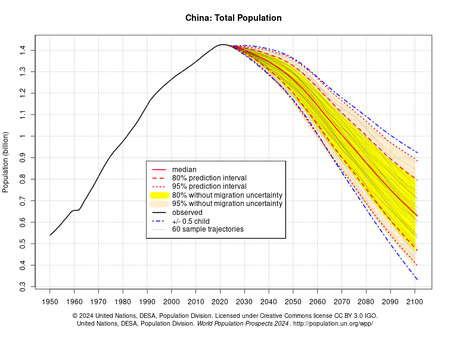In 2024 China exceeded 1.4 billion inhabitants, but according to the United Nations data that figure will begin to fall remarkably in the coming decades. The predictions speak that in 2050 the population will already have already decreased between 100 and 200 million people, and for 2100 in the best Chinese cases will have only 900 million inhabitants. Among many other things, there will be a huge impact on a key sector: that of the number of workers available.

Source: United Nations
In Economist they go further and stand out as today 22% of Chinese citizens are over 60 years old, but in 2035 that share will rise to 32.5%. Birth rates are also very low: to maintain the population that rate should be 2.1 children per woman, but in 2024 the rate was 1.0 children. And as they point out in Trivium China, the situation threatens to make China fall into “the average income trap”, slowing the growth of its economy because, simply, it cannot already have so much cheap labor and the export level that it had so far.
More productivity. The Xi Jinping solution lies in a concept that the Chinese government calls “new quality productive forces” (NQPF). It is a strategy to boost productivity, and for this you can take advantage of technological innovations, improve education or disseminate ideas and improvements throughout all industries. In April XI he already indicated that his 15th “five -year plan” (from 2026 to 2030) will precisely drive this type of measures. And above all, one.


Have more. That is where the so -called AI Plus directive, a long -term plan that in the next 10 years hopes to get AI becomes fully infiltrated the entire business and consumption fabric in China. The phases are clear:
- 2027: reach a penetration rate of more than 70 % of terminals and intelligent agents in six key sectors (science and technology, industry, consumption, social welfare, global governance and cooperation).
- 2030: That penetration rate must be 90%.
- 2025: According to the report, “the AI will be adopted as universally as electricity and the Internet, becoming the ‘basic infrastructure’ of society.”
In all areas. The plan pretends that AI is the great technological innovation that allows to boost productivity in all types of areas. For example in innovation and scientific discovery, but also in industrial transformation. In the latter case both agriculture and services are short -term objectives for the deployment of AI.

And also for consumption. In the consumer sector, AI must stimulate demand with the application of this technology in products such as connected cars or intelligent domestic devices. And of course, the objective is also that AI accompany and help all citizens in education, work or to improve health.
Governance and cooperation. The last two major sectors of the initiative are those that affect government efficiency – for example, for urban planning, national segurity or online censorship – and international competitiveness. In the latter case, the plan defends that AI must be considered an international public good and must follow an open source philosophy.
Straight. Some experts believe that the success of the AI Plus program is not insured, and there are also no clear metrics that really serve to measure the contribution of AI to economic growth. Jeffrey Ding, from the George Washington University, explains that “China faces a diffusion deficit because its ability to innovate and be a pioneer in new technologies far exceeds its ability to spread those advances throughout the economy.”
Low adoption. Although the country can train its best talents of AI in its best universities, it has certain problems to achieve that same training between “standard” ingenerios, which can create a barrier for the adoption of these technologies. A survey in 2022 confirmed that perception: only 4.5% of the companies owned by the Chinese government confirmed that the efforts to transform them digitally were “fulfilling expectations.”
And the AGI, what? Interestingly, in that document there is no mention of general artificial intelligence, which seems to suggest once again that China prefers to ensure that generative AI infiltrates throughout society instead of going in search of supremacy in AGI. That does not mean that China does not end up looking for this type of achievement, but at the moment its focus is another. A much more pragmatic and that is precisely aimed at mitigating the effects of its future demographic contraction.
Imagine | Global Panorama | Brian Matangelo
In WorldOfSoftware | China has found the formula to upload salaries while still being the world’s factory: a silent robots invasion












